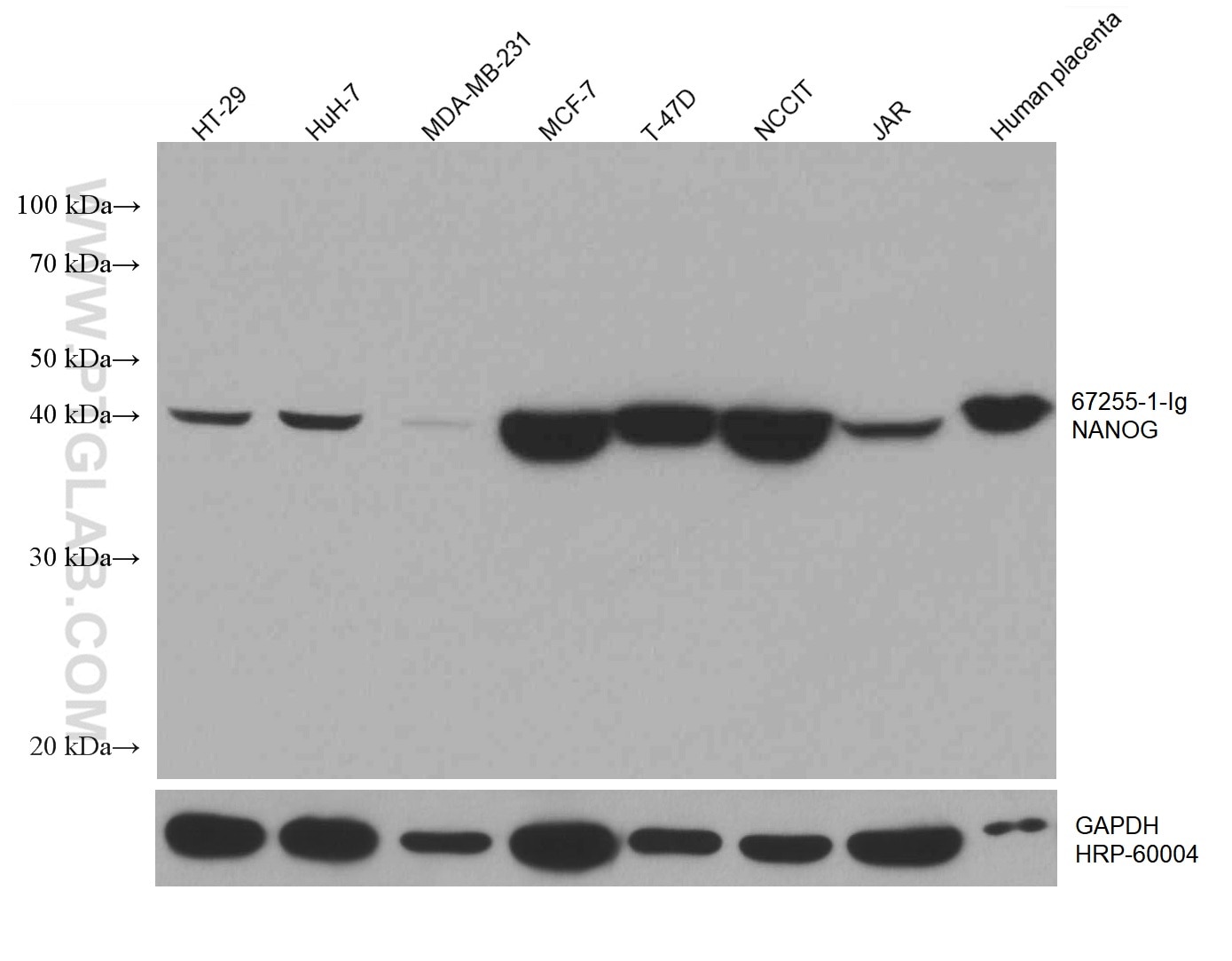Anticorps Monoclonal anti-Nanog
Nanog Monoclonal Antibody for WB, ELISA
Hôte / Isotype
Mouse / IgG2a
Réactivité testée
Humain, souris
Applications
WB, IF, ELISA
Conjugaison
Non conjugué
CloneNo.
3A2E1
N° de cat : 67255-1-Ig
Synonymes
Galerie de données de validation
Applications testées
| Résultats positifs en WB | cellules HT-29, cellules HuH-7, cellules JAR, cellules MCF-7, cellules MDA-MB-231, cellules NCCIT, cellules T-47D, tissu placentaire humain |
Dilution recommandée
| Application | Dilution |
|---|---|
| Western Blot (WB) | WB : 1:5000-1:50000 |
| It is recommended that this reagent should be titrated in each testing system to obtain optimal results. | |
| Sample-dependent, check data in validation data gallery | |
Applications publiées
| WB | See 18 publications below |
| IF | See 1 publications below |
Informations sur le produit
67255-1-Ig cible Nanog dans les applications de WB, IF, ELISA et montre une réactivité avec des échantillons Humain, souris
| Réactivité | Humain, souris |
| Réactivité citée | Humain |
| Hôte / Isotype | Mouse / IgG2a |
| Clonalité | Monoclonal |
| Type | Anticorps |
| Immunogène | Nanog Protéine recombinante Ag21364 |
| Nom complet | Nanog homeobox |
| Masse moléculaire calculée | 35 kDa |
| Poids moléculaire observé | 35-40 kDa |
| Numéro d’acquisition GenBank | BC160187 |
| Symbole du gène | Nanog |
| Identification du gène (NCBI) | 79923 |
| Conjugaison | Non conjugué |
| Forme | Liquide |
| Méthode de purification | Purification par protéine A |
| Tampon de stockage | PBS with 0.02% sodium azide and 50% glycerol |
| Conditions de stockage | Stocker à -20°C. Stable pendant un an après l'expédition. L'aliquotage n'est pas nécessaire pour le stockage à -20oC Les 20ul contiennent 0,1% de BSA. |
Informations générales
Nanog is a member of the homeobox family of DNA binding transcription factors and has been shown to maintain embryonic stem (ES) cell self-renewal independently of leukemia inhibitory factor (LIF)/Stat3. Nanog mRNA is present in pluripotent mouse and human cell lines, and absent from differentiated cells. Functionally, Nanog works together with other key pluripotent factors (Oct4, Sox2, and Lin28) to reprogram human fibroblasts and generate induced pluripotent stem (iPS) cells. These key factors form a regulatory network to support or limit each other's expression level, which maintains the properties of ES cells. Affinity purified rabbit anti-Nanog can be used to demonstrate pluripotency of ES and IPS cells. There are two kinds of variants could recognized by NANOG, one is normal form (~39kd), the other is post-translation modified form (~48kd) (21136380 ). Nanog exists two isoforms with molecular weight 34.4 kDa and 31.9 kDa. (PMID: 21969378)
Protocole
| Product Specific Protocols | |
|---|---|
| WB protocol for Nanog antibody 67255-1-Ig | Download protocol |
| Standard Protocols | |
|---|---|
| Click here to view our Standard Protocols |
Publications
| Species | Application | Title |
|---|---|---|
J Exp Clin Cancer Res Membrane RRM2-positive cells represent a malignant population with cancer stem cell features in intrahepatic cholangiocarcinoma | ||
J Pineal Res Melatonin inhibits the stemness of head and neck squamous cell carcinoma by modulating HA synthesis via the FOSL1/HAS3 axis | ||
Dent Mater Microspheres of stem cells from human exfoliated deciduous teeth exhibit superior pulp regeneration capacity | ||
iScience Arl4c promotes the growth and drug resistance of pancreatic cancer by regulating tumor-stromal interactions. | ||
Biomed Pharmacother Limonin enhances the radiosensitivity of nasopharyngeal carcinoma cells via attenuating Stat3-induced cell stemness. | ||


